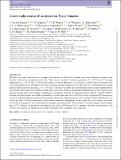Files in this item
A new radio census of neutron star X-ray binaries
Item metadata
| dc.contributor.author | van den Eijnden, J | |
| dc.contributor.author | Degenaar, N | |
| dc.contributor.author | Russell, T D | |
| dc.contributor.author | Wijnands, R | |
| dc.contributor.author | Bahramian, A | |
| dc.contributor.author | Miller-Jones, J C A | |
| dc.contributor.author | Santisteban, J V Hernández | |
| dc.contributor.author | Gallo, E | |
| dc.contributor.author | Atri, P | |
| dc.contributor.author | Plotkin, R M | |
| dc.contributor.author | Maccarone, T J | |
| dc.contributor.author | Sivakoff, G | |
| dc.contributor.author | Miller, J M | |
| dc.contributor.author | Reynolds, M | |
| dc.contributor.author | Russell, D M | |
| dc.contributor.author | Maitra, D | |
| dc.contributor.author | Heinke, C O | |
| dc.contributor.author | Padilla, M Armas | |
| dc.contributor.author | Shaw, A W | |
| dc.date.accessioned | 2021-09-30T11:30:01Z | |
| dc.date.available | 2021-09-30T11:30:01Z | |
| dc.date.issued | 2021-11 | |
| dc.identifier | 276086348 | |
| dc.identifier | eaa1fc83-3297-46d1-b820-de30a1624194 | |
| dc.identifier | 85116785489 | |
| dc.identifier | 000708848000054 | |
| dc.identifier.citation | van den Eijnden , J , Degenaar , N , Russell , T D , Wijnands , R , Bahramian , A , Miller-Jones , J C A , Santisteban , J V H , Gallo , E , Atri , P , Plotkin , R M , Maccarone , T J , Sivakoff , G , Miller , J M , Reynolds , M , Russell , D M , Maitra , D , Heinke , C O , Padilla , M A & Shaw , A W 2021 , ' A new radio census of neutron star X-ray binaries ' , Monthly Notices of the Royal Astronomical Society , vol. 507 , no. 3 , pp. 3899–3922 . https://doi.org/10.1093/mnras/stab1995 | en |
| dc.identifier.issn | 0035-8711 | |
| dc.identifier.other | Jisc: b20a891d6be945188f65084a5c235ea1 | |
| dc.identifier.other | ORCID: /0000-0002-6733-5556/work/100901678 | |
| dc.identifier.uri | https://hdl.handle.net/10023/24064 | |
| dc.description | Funding: JvdE is supported by a Lee Hysan Junior Research Fellowship awarded by St. Hilda’s College, and, together with ND, by an NWO Vidi grant awarded to ND. COH is supported by NSERC Discovery Grant RGPIN-2016-04602. TDR acknowledges financial contribution from ASI-INAF n.2017-14-H.0, an INAF main stream grant. | en |
| dc.description.abstract | We report new radio observations of a sample of thirty-six neutron star (NS) X-ray binaries, more than doubling the sample in the literature observed at current-day sensitivities. These sources include thirteen weakly-magnetised (B < 1010 G) and twenty-three strongly-magnetised (B ≥ 1010 G) NSs. Sixteen of the latter category reside in high-mass X-ray binaries, of which only two systems were radio-detected previously. We detect four weakly and nine strongly-magnetised NSs; the latter are systematically radio fainter than the former and do not exceed LR ≈ 3 × 1028 erg/s. In turn, we confirm the earlier finding that the weakly-magnetized NSs are typically radio fainter than accreting stellar-mass black holes. While an unambiguous identification of the origin of radio emission in high-mass X-ray binaries is challenging, we find that in all but two detected sources (Vela X-1 and 4U 1700-37) the radio emission appears more likely attributable to a jet than the donor star wind. The strongly-magnetised NS sample does not reveal a global correlation between X-ray and radio luminosity, which may be a result of sensitivity limits. Furthermore, we discuss the effect of NS spin and magnetic field on radio luminosity and jet power in our sample. No current model can account for all observed properties, necessitating the development and refinement of NS jet models to include magnetic field strengths up to 1013 G. Finally, we discuss jet quenching in soft states of NS low-mass X-ray binaries, the radio non-detections of all observed very-faint X-ray binaries in our sample, and future radio campaigns of accreting NSs. | |
| dc.format.extent | 24 | |
| dc.format.extent | 1264489 | |
| dc.language.iso | eng | |
| dc.relation.ispartof | Monthly Notices of the Royal Astronomical Society | en |
| dc.subject | Stars: neutron | en |
| dc.subject | Binaries | en |
| dc.subject | Accretion | en |
| dc.subject | Accretion discs | en |
| dc.subject | QB Astronomy | en |
| dc.subject | QC Physics | en |
| dc.subject | DAS | en |
| dc.subject.lcc | QB | en |
| dc.subject.lcc | QC | en |
| dc.title | A new radio census of neutron star X-ray binaries | en |
| dc.type | Journal article | en |
| dc.contributor.institution | University of St Andrews. School of Physics and Astronomy | en |
| dc.identifier.doi | https://doi.org/10.1093/mnras/stab1995 | |
| dc.description.status | Peer reviewed | en |
This item appears in the following Collection(s)
Items in the St Andrews Research Repository are protected by copyright, with all rights reserved, unless otherwise indicated.

